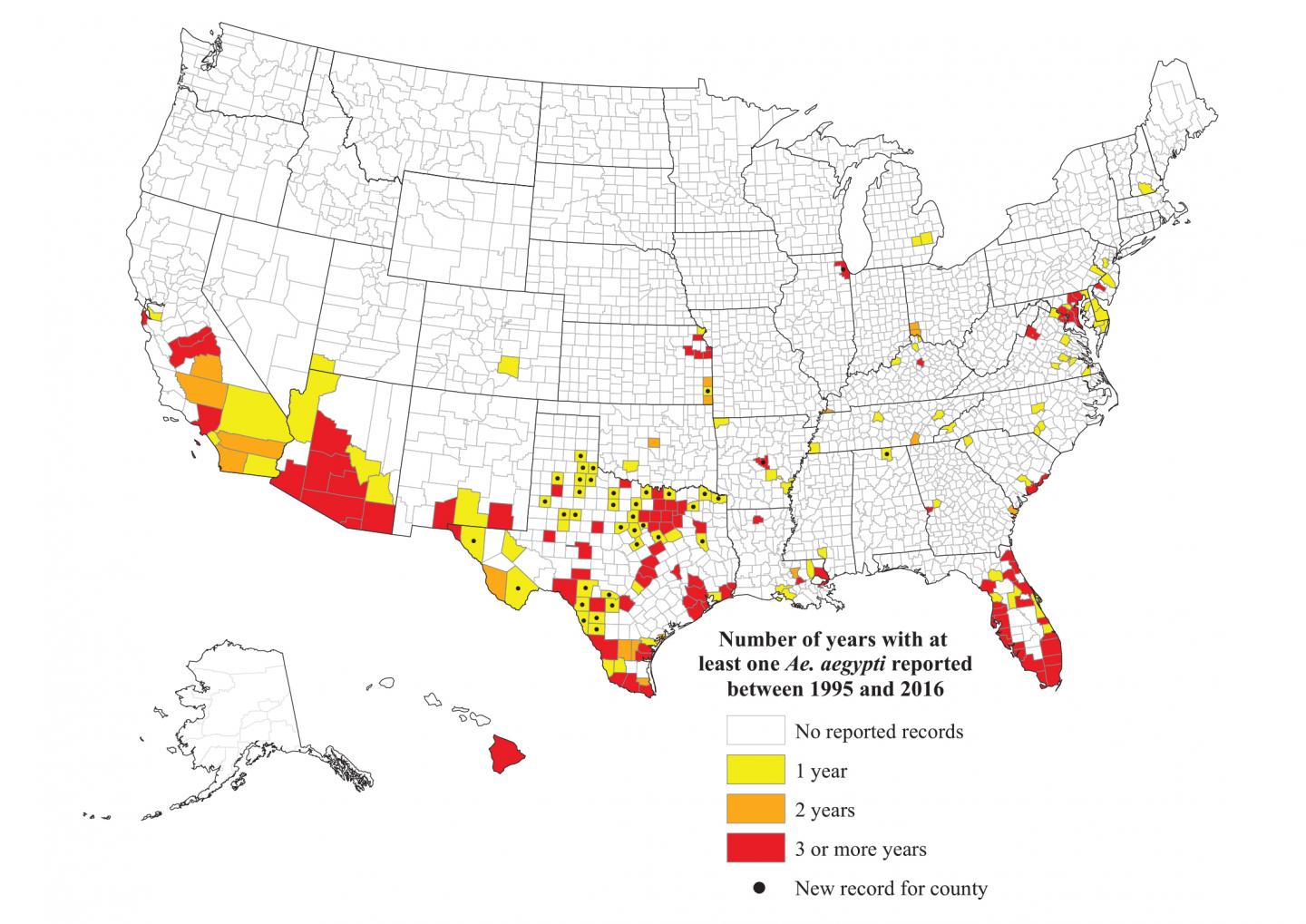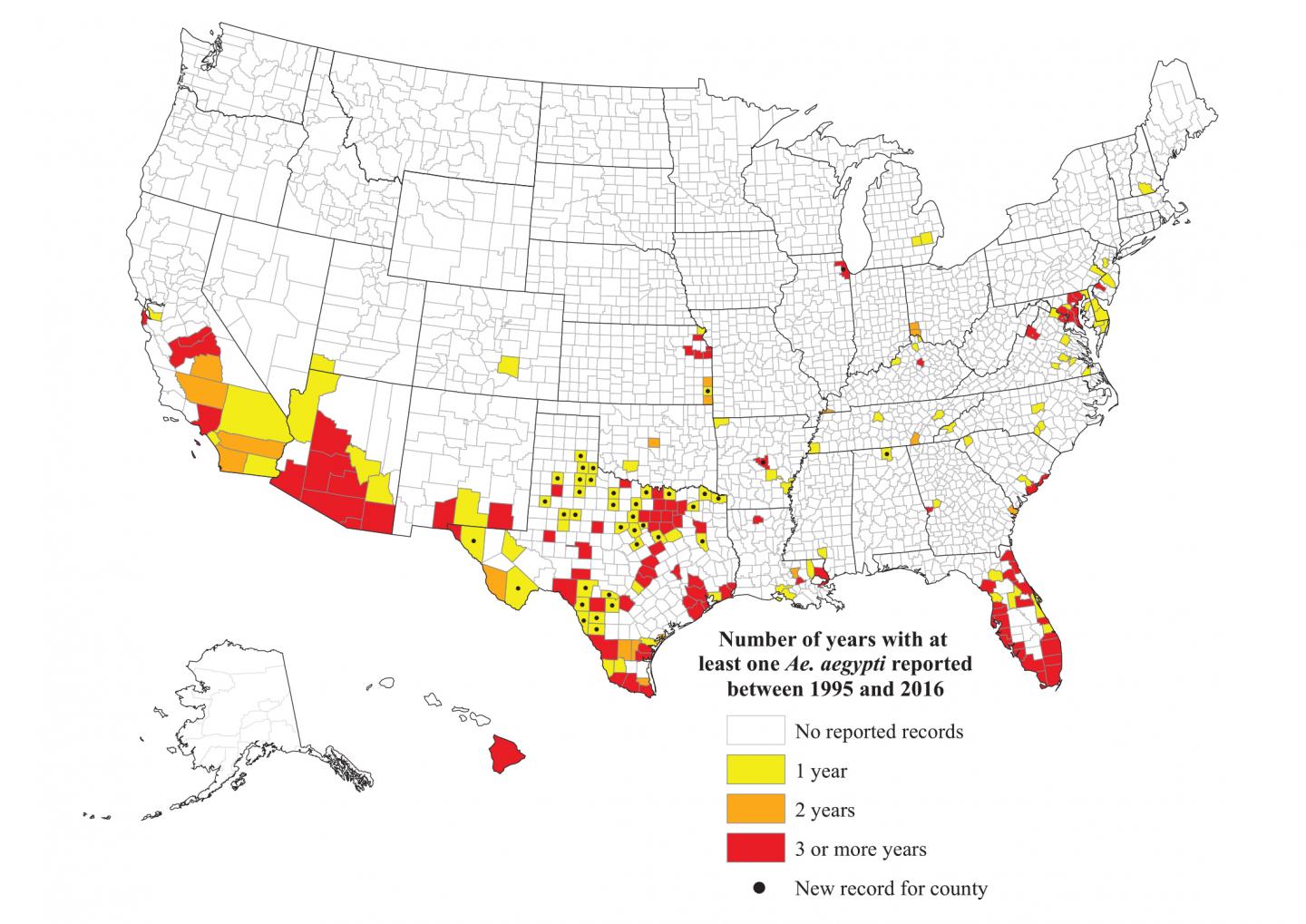
Credit: Centers for Disease Control and Prevention
Annapolis, MD; June 19, 2017–As concerns over Zika virus have grown since 2015, the U.S. Centers for Disease Control and Prevention (CDC) has turned to local public health professionals to compile data on distribution of the two primary mosquito species capable of transmitting the virus, Aedes aegypti (the primary vector for Zika) and Aedes albopictus. Their findings highlight both the potential widespread presence of the mosquitoes as well as gaps in local surveillance capabilities crucial to understanding the threat of Zika and other mosquito-borne diseases such as dengue and chikungunya. Through a county-level survey of vector-control professionals, entomologists, and state and local health departments, conducted initially in 2015 and again in 2016, CDC researchers developed what they call "our best knowledge regarding the current distribution of Ae. aegypti and Ae. albopictus in the United States." Reported in the Entomological Society of America's Journal of Medical Entomology, the historical county-level records compiled by the CDC show Ae. aegypti reported in 220 counties in 28 states and the District of Columbia between 1995 and 2016 and Ae. albopictus reported in 1,368 counties in 40 states and DC during that time.
In addition, the data show that in some places the percent of mosquitos found during 1995-2016 was higher, though the researchers attribute the increase not to any sudden spread of the mosquitoes but rather to the increased attention on the risks posed by Zika and other diseases, says Rebecca Eisen, Ph.D., research biologist with CDC's Division of Vector-Borne Diseases and co-author of the study.
"The study reveals gaps in mosquito distributions–likely resulting from lack of local surveillance rather than mosquitoes being absent," she says. "Prompted by the Zika outbreak, states began work to better assess the distribution and abundance of these mosquitoes, locally. The updated survey CDC conducted in fall 2016 demonstrated that intensified surveillance in the summer of 2016 resulted in Ae. aegypti or Ae. albopictus being collected in many counties where there were no records for them in recent decades."
Eisen emphasizes that the findings illustrate the presence, not abundance, of the mosquito species, and they are not meant to represent risk for spread of Zika or any other disease. The findings also do not show how many mosquitoes are living in an area or the exact locations of the mosquitoes. But the data does allow the CDC and local stakeholders to better direct surveillance and control efforts. For instance, in counties where Ae. aegypti or Ae. albopictus have not been recorded but that neighbor areas where they have, the CDC can model the county's suitability for the mosquitoes to be present.
"This information will help to target limited public health surveillance resources and help to improve our understanding of how widespread these mosquitoes are," Eisen says.
For the survey, the mosquito species was considered "present" in a county in a given calendar year if at least one specimen of any life stage of the mosquito was collected, using any collection method, during that year. Ae. aegypti was reported in all southern U.S. states, with most county reports coming from southern California, Arizona, Texas, Louisiana, and Florida. Reports in neighboring Alabama, Mississippi, Georgia, and South Carolina, however, were more sporadic. Ae. aegypti is generally known to thrive in tropical and subtropical climates.
The distribution of reports of Ae. albopictus was greater and more consistent in the Southeast and Mid-Atlantic states and even southern New England. It was also recorded in a few counties in the Southwest, including California, Arizona, and New Mexico.
###
"Updated Reported Distribution of Aedes (Stegomyia) aegypti and Aedes (Stegomyia) albopictus (Diptera: Culicidae) in the United States, 1995-2016," by Micah B. Hahn, Lars Eisen, Janet McAllister, Harry M. Savage, John-Paul Mutebi, and Rebecca J. Eisen, will be published online on June 19 in the Journal of Medical Entomology. Journalists may request advance copies of the article via the contact below.
CONTACT: Joe Rominiecki, [email protected], 301-731-4535 x3009
ABOUT: ESA is the largest organization in the world serving the professional and scientific needs of entomologists and people in related disciplines. Founded in 1889, ESA today has over 6,000 members affiliated with educational institutions, health agencies, private industry, and government. Headquartered in Annapolis, Maryland, the Society stands ready as a non-partisan scientific and educational resource for all insect-related topics. For more information, visit http://www.entsoc.org.
The Journal of Medical Entomology publishes research related to all aspects of medical entomology and medical acarology, including the systematics and biology of insects, acarines, and other arthropods of public health and veterinary significance. For more information, visit https://academic.oup.com/jme, or visit http://www.insectscience.org to view the full portfolio of ESA journals and publications.
Media Contact
Joe Rominiecki
[email protected]
301-731-4535 x3009
@EntsocAmerica
http://www.entsoc.org
Related Journal Article
http://dx.doi.org/10.1093/jme/tjx088
############
Story Source: Materials provided by Scienmag





